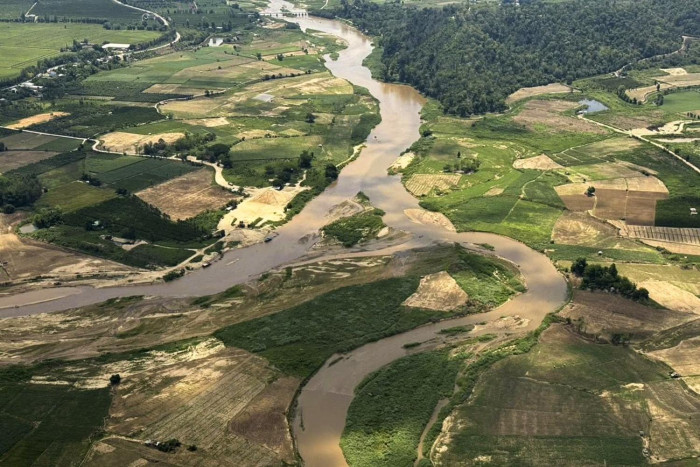The Kok River, once a lifeline for communities across northern Thailand, is facing an environmental catastrophe.
Originating in Myanmar, the river is now heavily contaminated with toxic substances believed to come from mining operations in the upstream Wa-controlled territory — a politically sensitive area with which the Thai state has yet to establish any formal dialogue.
The river, once clear and pristine, now runs red and murky. The dramatic change has frightened local residents in both Chiang Mai and Chiang Rai, who now avoid using the water out of fear of chemical poisoning. Freshwater fishers have reported mass infections and wounds on fish, rendering them unsafe for consumption.
Livelihoods and local tourism — particularly in Chiang Rai — have taken a major hit, as residents are warned against bathing, fishing, or even allowing animals to enter the river.
Geographic and environmental impact
The Kok River enters Thailand at Mae Ai district in Chiang Mai before flowing through neighbouring Chiang Rai and merging with the Mekong River in Chiang Saen district — a total length of about 180 kilometres inside Thai territory.
Recent water tests revealed that levels of arsenic — a toxic heavy metal — exceed Thailand’s legal limit of 0.010 mg/L at all 15 test points along the river and its tributaries. Arsenic contamination has also been detected in the Sai and Mekong rivers.
On June 10, the Pollution Control Department (PCD) posted results from its fourth round of water sampling (conducted May 26–30), showing consistent arsenic contamination at all monitored locations. Testing included sediment and water quality at 15 sites along the Kok River and its tributaries — including the Fang, Lao, Korn, Suai, and Sai rivers — as well as two sites on the Mekong.
Abnormally high turbidity and arsenic levels were found near the Myanmar border, strongly suggesting contamination from upstream mining activity. Arsenic detected in the Mekong River may originate from tributaries like the Sai and Ruak rivers. Further testing is needed to determine whether contamination also comes from Lao territory. The onset of the rainy season and the opening of the Chiang Rai dam gates increased sediment flow, stirring up contaminated deposits and possibly spreading arsenic further downstream.
Health warnings and community risk
Somporn Phengkham, director of the Community Health Impact Assessment Platform (CHIA), confirmed elevated arsenic levels throughout the Kok River. Although arsenic concentration appears to be decreasing near the headwaters in tambon Tha Ton, it is increasing midstream, likely due to sediment release from the Chiang Rai weir.
She emphasised the urgent need for more frequent testing of tap and village water supplies, assessment and treatment of agricultural water sources, and the immediate testing of shallow wells, which are prevalent among riverside communities and vulnerable to contamination through soil infiltration.
Ms Somporn urged authorities to distribute DIY test kits so villagers can detect heavy metal contamination themselves.
“Even if levels are only slightly above the legal limit, daily exposure leads to chronic accumulation in the human body. Today, it may seem harmless, but over time, it becomes a long-term health threat,” she warned.
A transboundary crisis
Lalita Harnwong, a historian at Kasetsart University and an expert on Myanmar’s ethnic minorities, labelled the situation a “five-star national security issue”. She drew parallels to the ongoing scam centre crisis along the border, which remains unresolved despite government interventions.
She called for government transparency, acknowledging the Kok River pollution as a critical security threat. The historian also said there must be urgent diplomatic engagement with the United Wa State Army (UWSA), the de facto authority in the contaminated upstream region.
“Negotiations can happen, but Thailand must send a clear message to Naypyidaw that it intends to address this as a matter of national security.
“While villagers suffer chronic poisoning, we can’t keep hiding behind the notion that the Wa aren’t a state. This logic must be dismantled,” Ms Lalita asserted.
Government inaction and suppression of information
Senator Angkhana Neelapaijit, chair of the Senate Committee on Political Development, visited the area with civil society members. She expressed shock that provincial authorities had known about the arsenic contamination but were allegedly asked by higher-ups to suppress the information.
“The most vulnerable — children — are being exposed daily. If elephants have developed boils after bathing in the Kok River, what about the children playing in the water?” she asked, calling for the government to leverage Asean regional mechanisms and its ties with China, which has financial stakes in the mining industry.
Tourism devastated, livelihoods lost
Sriton Kamphaeng, manager of the Karen Ruammit Elephant Camp — an international tourist destination — shared that his business has suffered immensely.
“Tour boats can’t operate. Elephants can’t drink or bathe in the river. We had to lay a four-kilometre pipeline from a mountain spring just to get clean water,” he said. Back in February, when the river had already turned murky, mahouts unknowingly led elephants into the water. “The elephants developed rashes and pus-filled sores on their skin,” Mr Sriton recalled grimly.
Provincial government’s limited power
Chiang Rai governor Charin Thongsuk acknowledged the gravity of the situation, stating that he, too, is a victim — as he uses the same water sources as residents. He said that while the root cause is in another country, Chiang Rai has no jurisdiction to intervene upstream.
Two immediate actions have been taken: confirming the safety of tap water, which currently remains below arsenic thresholds; and requesting the Department of Environmental Quality to continue monitoring water trends.
A long-term solution may involve building more sediment retention dams, as recommended by the Pollution Control Department.
“The best outcome would be clean water entering from Myanmar, but until then, we must minimise arsenic entering our territory.
“While residents are advised to avoid river contact, the tap water is still considered safe. We are doing what we can within our limited powers,” Mr Charin concluded.

Leave a Reply Cancel reply